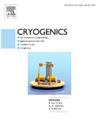Experimental evaluation of a thermal interface and a cold circulator used in remote cooling loop driven by a cryocooler
IF 2.1
3区 工程技术
Q3 PHYSICS, APPLIED
引用次数: 0
Abstract
Due to helium’s limited accessibility and non-renewable nature, superconducting systems need more sustainable alternatives to cryogenic plants, which feature elevated helium losses. Cryogenic systems based on commercially available cryocoolers are seen as a promising solution. In this paper, a remote cooling loop driven by a cryocooler and cold circulator is introduced, and an experimental study of the heat exchanger serving as the cryocooler-to-gas thermal interface is presented. This thermal interface is intended for integration into a remote cooling system, which is designed to intercept the 300 W heat load from 3 kA hybrid current leads. The heat exchanger successfully maintained a gas outlet temperature below 50 K under 300 W. A mathematical model is developed to forecast both the gas outlet temperatures and the cooling capacity of the heat exchanger for a given geometry, and validation is conducted using experimental data. Furthermore, an experimental verification of the isentropic efficiency of the selected cold circulator is included. Finally, an estimation of the mass flow within the hydraulic system is presented and compared with the measured results.
冷冻机驱动的远程冷却回路用热界面和冷循环器的实验评价
由于氦气的可及性和不可再生性有限,超导系统需要更可持续的替代品来替代低温工厂,低温工厂的特点是氦气损失增加。基于商用制冷机的低温系统被视为一种有前途的解决方案。本文介绍了一种由制冷机和冷循环器驱动的远程冷却回路,并对换热器作为制冷机-气体热界面进行了实验研究。该热接口旨在集成到远程冷却系统中,该系统旨在拦截来自3 kA混合电流引线的300 W热负荷。在300w下,换热器成功地将气体出口温度保持在50k以下。建立了一个数学模型来预测给定几何形状下换热器的出口温度和制冷量,并用实验数据进行了验证。此外,还对所选冷循环器的等熵效率进行了实验验证。最后,对液压系统内的质量流量进行了估计,并与实测结果进行了比较。
本文章由计算机程序翻译,如有差异,请以英文原文为准。
求助全文
约1分钟内获得全文
求助全文
来源期刊

Cryogenics
物理-热力学
CiteScore
3.80
自引率
9.50%
发文量
0
审稿时长
2.1 months
期刊介绍:
Cryogenics is the world''s leading journal focusing on all aspects of cryoengineering and cryogenics. Papers published in Cryogenics cover a wide variety of subjects in low temperature engineering and research. Among the areas covered are:
- Applications of superconductivity: magnets, electronics, devices
- Superconductors and their properties
- Properties of materials: metals, alloys, composites, polymers, insulations
- New applications of cryogenic technology to processes, devices, machinery
- Refrigeration and liquefaction technology
- Thermodynamics
- Fluid properties and fluid mechanics
- Heat transfer
- Thermometry and measurement science
- Cryogenics in medicine
- Cryoelectronics
 求助内容:
求助内容: 应助结果提醒方式:
应助结果提醒方式:


